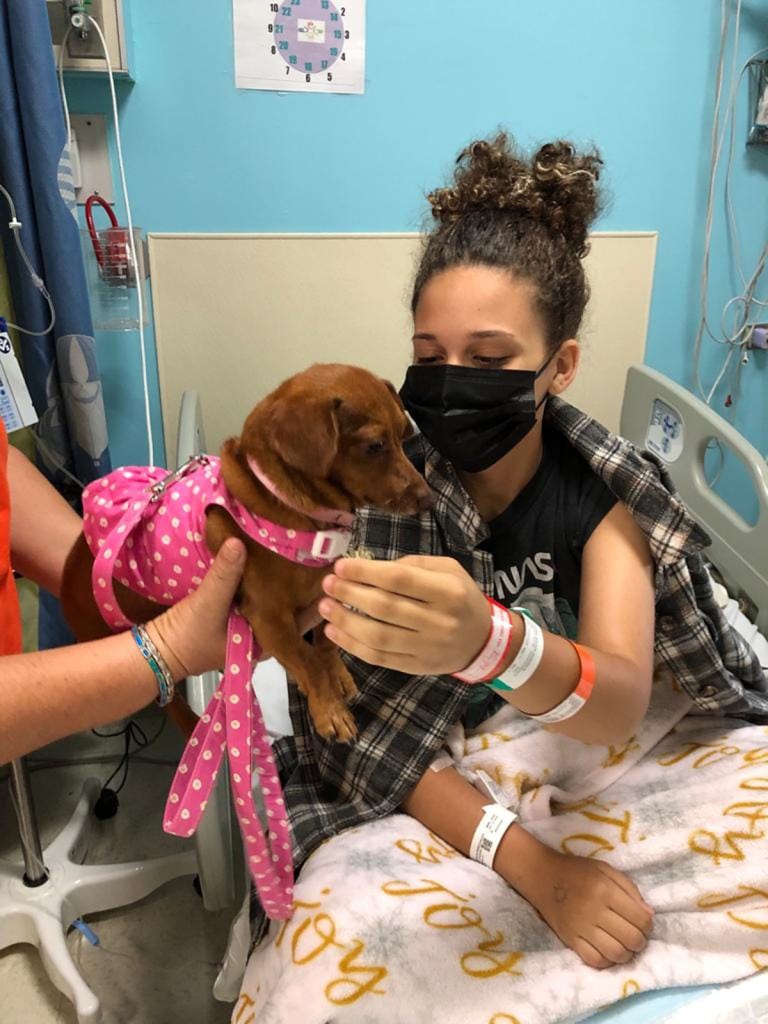When therapy dogs walk through the door of the emergency room at the Mayagüez Medical Center in Puerto Rico, the atmosphere changes. “You can feel the tension lift, and you can see the happiness on the faces of the patients and staff when they see the dogs,” said Joy Carson, a member of Puerto Rico Therapy Dogs Inc., who visited the hospital recently with her husband Ken and their therapy dogs Rosalie and Enzo. Along with medical centers, members of the nonprofit group visit such facilities as children’s hospitals, help centers for people with disabilities, and schools.
In addition to spreading love and comfort, a recent study published in the journal PLOS ONE revealed that the presence of therapy dogs provides significant reductions in pain, anxiety, and depression to patients in medical settings. According to experts at the Alliance of Therapy Dogs, being around these furry volunteers can also decrease stress, sadness, and fatigue in dementia patients, those suffering from anxiety, and people with post-traumatic stress disorder.

What exactly is a therapy dog?
It’s important to understand the difference between service dogs, emotional support dogs, and therapy dogs.
Service dogs go through extensive training to help a person with a disability live a more independent life. Legally, service dogs have full public access rights, which means they’re allowed to go places off-limit to animals.
Emotional support dogs are typically trained to assist owners who have diagnoses of psychological or emotional disorders. Emotional support dogs have limited legal rights and typically an owner is required to present a letter of diagnosis from a doctor or a psychologist before gaining access to areas off-limits to dogs.
Therapy dogs provide comfort and affection while interacting with a wide range of people in a variety of settings. Therapy dogs also help console people in the aftermath of disasters, such as hurricanes or mass shootings.
How to know if your dog qualifies for therapy work
According to experts at Therapy Dogs International (TDI), “a therapy dog is born, not made.” While you can teach your dog basic obedience, you can’t change a dog’s inherent temperament. When a dog is under stress, poor or marginal temperament will surface, making the dog unfit for therapy work, said TDI trainers.
Personality traits of therapy dogs include being friendly, outgoing, gentle, calm, and confident around people and pets. These four-legged volunteers come in all shapes and sizes, with some purebreds becoming certified after retiring from the show ring, while many mixed-breed dogs excel in therapy work after being adopted from shelters or rescues. Typically, dogs have to be at least a year old before they can be certified for therapy work.
In a Newsweek article, Mary Burch, director of the American Kennel Club (AKC) Canine Good Citizen Program, said that matching dogs to the right setting is important when it comes to therapy work. For example, smaller breeds like Rosalie and Enzo, both rescue dogs, work well in hospital settings where people can place them on beds or laps, making it easier for patients to pet them. Burch says that larger more active breeds like golden retrievers work well in a setting such as a residential home for teenage boys where residents might enjoy playing ball or Frisbee with the dogs.
Popular large-breed therapy dogs include:
- Golden retrievers
- Labrador retrievers
- Greyhounds
- Standard poodles
Popular small-breed therapy dogs include:
- Beagles
- Cavalier King Charles spaniels
- Dachshunds
- Yorkshire terriers
In addition to having the right temperament, therapy dogs have to be clean, well groomed, and current on core vaccinations.

How to get therapy dog certification
In the U.S., several organizations train and certify therapy dog teams and each has its own set of rules and regulations.
Because all therapy dogs need to have good manners, basic obedience training is a must. Training experts at the AKC recommend that dogs complete the AKC’s Canine Good Citizen (CGC) test before taking a therapy certification test. The CGC teaches basic good manners, including come, sit, stay, down, and good behavior around other dogs.
Once you’re confident with your dog’s obedience skill level, you can reach out to a reputable therapy dog group. Among the largest and most popular groups operating in the U.S. are the Alliance of Therapy Dogs, Bright and Beautiful Therapy Dogs, and Therapy Dogs International. The AKC also offers a list of local therapy dog organizations, along with the states in which they operate.
Typically, dogs are required to pass a test before being certified for therapy work. In addition to observing a dog’s basic obedience skills, these tests are designed to evaluate a dog’s reaction when confronted with typical therapy dog settings. For example, during testing, dogs may be exposed to people on crutches, in wheelchairs, or using walkers. The dogs may also be subjected to loud noises or people running past them from behind — all experiences they may encounter while working. Evaluators watch to make sure that dogs remain calm in difficult, distracting, or stressful situations.
Once registered, you’ll learn from experienced handlers the skills needed when visiting facilities with your dog. In addition, therapy organizations provide members with the necessary liability insurance to protect them while volunteering.
Yes, there’s some preparation involved in getting your pet ready for therapy work, but the benefits are enormous. Volunteering to help others is a heartwarming experience. Taking your dog along on the adventure strengthens the bond you have with one another while working as a team to help those in need.
Editors' Recommendations
- Are ‘dog years’ really 7 human years? How to calculate your dog’s age
- Why does my dog have a bald patch on their tail? Here are the answers you need
- Looking for signs your dog has ticks? These telltale symptoms mean you have a flea or tick problem
- Where to put a dog crate in your house depends on these important factors
- Does your dog drink a lot of water? Here’s when you should be concerned





